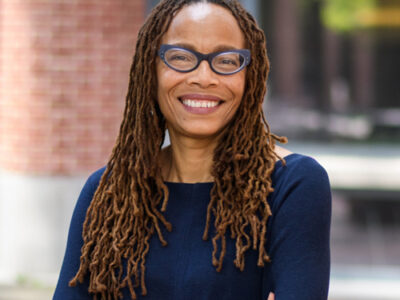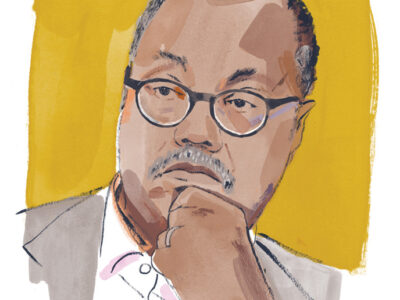
Stem-cell research is not a topic that easily lends itself to distillation or sound-bites, as Dr. Robert Barchi Gr’72 M’72 GM’73, the provost and professor of neurology, readily acknowledged. But on a sweltering summer’s afternoon, he stepped up to a podium at 37th and Locust Walk and delivered a highly condensed lecture on the subject to 50-some listeners, drawn by a combination of subject matter, speaker, free calzones, and some classical guitar. (Actually, the warning-level heat probably drove down the attendance somewhat, since usually between 100 and 200 people attend.)
Barchi’s talk was part of the University’s “60-second lecture” series, which was started in 1999 by Valerie Ross, director of the Summer Sessions program. The lectures are offered during the two summer sessions, which end in August.
“I was looking around for things that might create more life on campus in the summer, when things are very quiet,” Ross recalls. After considering and disregarding the idea of a more traditional lecture series, she approached several faculty members to talk about the subject of “error.” One talked for about a minute, and said: “That’s all I have to say about that.” Another came to the exact same conclusion.
“It seemed to me perfect,” says Ross. She describes the series as a “collective intellectual and esthetic experience” that draws everyone from construction workers and neighborhood kids to Penn students, faculty, and staff. Sometimes, she adds, faculty members “turn out and heckle other faculty,” providing some good-natured intellectual sparks.
Among the speakers have been Dr. Robert Giegengack, chairman of the Department of Earth and Environmental Science (who spoke on “Geological Time Compared to a Roll of Toilet Paper”); Penn President Judith Rodin (on West Philadelphia); Nursing Professor Neville Strumpf (on “Benjamin Franklin and Nursing”); and English Professor Al Filreis, who offered “four propositions about why we should live to see the end of the lecture as we know it.”
Ross calls them the “essence of the finest lectures” from “outrageously good lecturers.” And while Rodin and Barchi both stretched the definition
of a minute a bit, Ross says that most of the faculty pride themselves on staying “very close to and sometimes right on 60 seconds.”
“This was fun,” said Barchi after the stem-cell talk. “It’s also important stuff.” And while he barely had time to lay out the salient arguments, he pointed out: “If it gets people thinking, it’s worth it.”
Dr. Robert Barchi’s 60-second lecture, in its entirety:
This month President Bush is expected to decide whether to fund research on stem cells taken from four-day-old frozen human embryos. These are surplus embryos that were prepared for in-vitro fertilization but no longer needed and are scheduled to be discarded by fertility clinics. The president’s decision will have a profound impact on the future of research at Penn and other research institutions in our country.
To its proponents, stem-cell research holds out hope for treatment, and even cure, of a variety of debilitating and often fatal disorders, ranging from diabetes to Alzheimer’s disease.
To its opponents, this research further erodes our respect for life.
So what are stem cells, anyway?
Four days after an egg is fertilized, the dividing cells have formed a tiny hollow ball. Although most cells in this ball are destined to form the placenta, one special clump of cells will eventually become the fetus. These are the stem cells. At this stage, these stem cells have not yet determined their ultimate role, and each still has the potential to become one of more than 200 tissue types in the body. Scientists can now isolate
these stems cells, induce them to multiply, and then preferentially direct them to become, for example, skin cells, nerve cells, or heart cells.
This extraordinary scientific advance opens the door to replacing damaged adult cells that are not able to regenerate in the brain, spinal cord, or heart; and it may ultimately allow us to grow replacement organs for those in need of a new heart, lung, or liver.
The issue being discussed now is not the potential scientific value of stem-cell research, but rather the ethical, moral, and political questions it raises. As with the abortion debate, much of the argument centers on when life begins. Does a four-day embryo that has existed only in a petri dish, will never be nurtured by a human uterus, and will soon be discarded, have the same status as a six-month fetus, already capable of life outside the womb? This heated discussion does not divide neatly along “pro-life” and “pro-choice” lines, and many staunch pro-life advocates in and out of government have publicly declared their support for stem-cell research.
One hundred-twelve college and university presidents, including our own, have written letters urging President Bush to allow the research to move forward in a thoughtful, carefully monitored way.
In the coming months, I urge you to listen carefully as the debate continues. Form your own opinion and let it be heard. There has rarely been a more important intersection between academic research and public policy. Don’t let their size fool you—stem cells are the biggest thing we’ve seen in a long time.
(Note: On August 9, President Bush approved limited federal funding for stem-cell research.)




